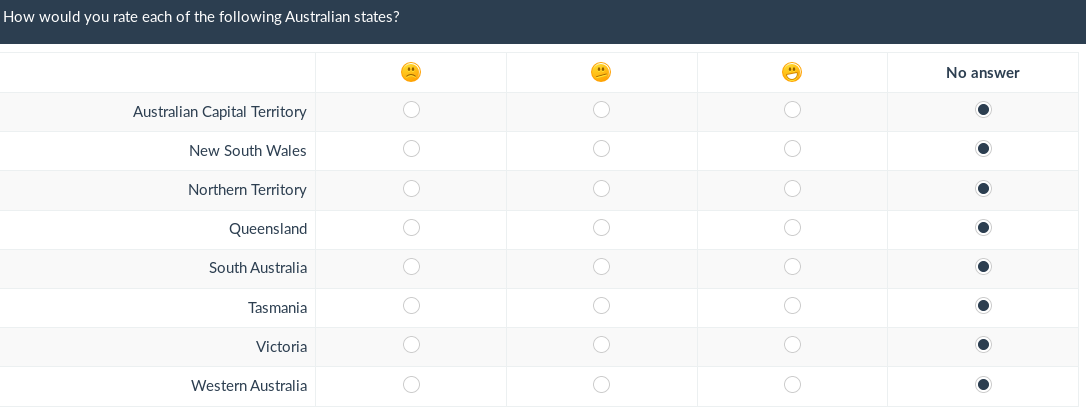Label sets/de: Difference between revisions
From LimeSurvey Manual
Surveyunihi (talk | contribs) (Created page with "Weiterhin können Sie Beschriftungen über die Schaltfläche '''Schnelles Hinzufügen ...''' hinzufügen. nach einem Klick auf diese Schaltfläche erscheint ein PopUp-Fenster,...") |
Surveyunihi (talk | contribs) (Created page with "Diese so erfassten Beschriftungen können entweder den vorhandenen hinzugefügt (Schaltfläche '''Hinzufügen''') werden oder diese ersetzen (Schaltfläche '''Ersetzen''').") |
||
| Line 116: | Line 116: | ||
Diese so erfassten Beschriftungen können entweder den vorhandenen hinzugefügt (Schaltfläche '''Hinzufügen''') werden oder diese ersetzen (Schaltfläche '''Ersetzen'''). | |||
Revision as of 13:07, 5 July 2018
General
Beschriftungssets sind ihrer Natur nach vorgefertigte Listen, wobei jede Liste einen Satz von Codes mit zugehörigen Beschriftungen enthält. Diese Listen können in vielen Fragetypen entweder als Antwortoptionen oder als Unterfragen verwendet werden. Bitte beachten Sie, dass bei der Verwendung eines Beschriftungssets in einer Frage eine Kopie des aktuellen Zustands erfolgt, d.h. spätere Änderungen am Beschriftungsset werden nicht in der Frage nachvollzogen.
Es folgt eine Beispiel eines Beschriftungssets, anhand dessen Sie das Konzept kennen lernen. Oder springen Sie gleich zum praktischen Verwalten von Beschriftungssets.
Das folgende Beispiel zeigt eine einfache 7-Punkte-Skala, die mit Hilfe von Beschriftungssets leicht anzulegen ist. Das Beschriftungsset besteht aus 7 Code/Beschriftungs-Paaren; im Fragebogen sichtbar werden dabei nur die Beschriftungen.
| Code | Beschriftung |
| 1 | Nicht hilfreich |
| 2 | 2 |
| 3 | 3 |
| 4 | Etwas hilfreich |
| 5 | 5 |
| 6 | 6 |
| 7 | Sehr hilfreich |
Ein weiteres Beispiel, bei dem anstelle von textuellen Beschriftungen Smiley verwendet werden:
Beschriftungssets: Wie man ...
Klicken Sie auf Beschriftungseinstellungen verwalten im Menüpunkt Administration, um Beschriftungssets anzulegen, zu editieren, zu löschen und zu im- oder exportieren.

...ein neues Beschriftungsset erstellt oder importiert
Klicken Sie auf die Schaltfläche Neue(s) Beschriftungsset(s) erstellen oder importieren oben links auf der Seite. Sie können entweder ein neues Beschriftungsset komplett neu erstellen oder es importieren:
Neues Beschriftungset
- Name setzen: Jedem Beschriftungsset muss ein eindeutiger Name zugewiesen werden.
- Sprachen: Für jedes Beschriftungset muss definiert werden, in welchen Sprachen es zur Verfügung stehen soll. Sie können beliebig viele Sprachen hinzufügen.
Beschriftungset(s) importieren
- Beschriftungsset-Datei auswählen (* .lsl): Hier können Sie eine Datei, die ein Beschriftungsset enthält (Dateiendung: .lsl) auswählen.
- Nicht importieren wenn Beschriftungsset schon existiert: Ist diese Option ausgewählt, wird verhindert, dass ein gleichnamiges bereits existierendes Beschriftungsset überschrieben wird.
Sie finden einige nützliche Beispiele für Beschriftungssets auf der LimeSurvey website.
Nach dem Sie ein Beschriftungsset erstellt oder importiert haben, klicken Sie auf die Schaltfläche Speicher rechts oben auf dem Bildschirm.
... ein Beschriftungsset bearbeitet, löscht oder exportiert
Jedes Beschriftungsset aus der Beschriftungssetliste hat ein Menü mit den folgenden vier Schaltflächen am rechten Rand der Liste:
- Beschriftungen anzeigen: Hiermit können Sie die Beschriftungen und Codes dieses Beschriftungsets ansehen und bearbeiten (siehe folgender Abschnitt).
- Beschriftungsset bearbeiten: Hier können Sie den Namen des Beschriftungssets ändern sowie verfügbare Sprachen hinzufügen oder löschen.
- Beschriftungsset exportieren: Hier können Sie das gewählte Beschriftung-Set in eine Datei im .lsl-Format exportieren.
- Beschriftungsset löschen: Nach einer Bestätigung können Sie das gewählte Beschriftungsset löschen.
Beschriftungen: Wie man ...
...eine Beschriftung hinzufügt
Sie müssen einen (Beschriftungs-)Code, einen Bewertungswert und die Beschriftung selber (Titel) angeben.

klicken Sie dann auf das Plus-Zeichen ![]() , um die neue Beschriftung hinzuzufügen.
Es besteht die Möglichkeit, dass man an Stelle oder zusätzlich zum Beschriftungstext eine Grafik einbindet. Hier kann man normalen HTML-Code verwenden, z.B.:
, um die neue Beschriftung hinzuzufügen.
Es besteht die Möglichkeit, dass man an Stelle oder zusätzlich zum Beschriftungstext eine Grafik einbindet. Hier kann man normalen HTML-Code verwenden, z.B.:
<img border="0" src="http://www.ihredomain.de/pics/pic.gif">benutzen Sie für eine erleichterte Eingabe von HTML-Code den eingebauten HTML-Editor von LimeSurvey, den Sie am rechten Ende des Eingabefeldes für den Beschriftungstext mit einem Klick auf den grünen Stift ![]() erreichen.
erreichen.

Schnelles Hinzufügen
Weiterhin können Sie Beschriftungen über die Schaltfläche Schnelles Hinzufügen ... hinzufügen. nach einem Klick auf diese Schaltfläche erscheint ein PopUp-Fenster, wo Sie beschriftungen im Format Code;Beschriftungstext eingeben können.
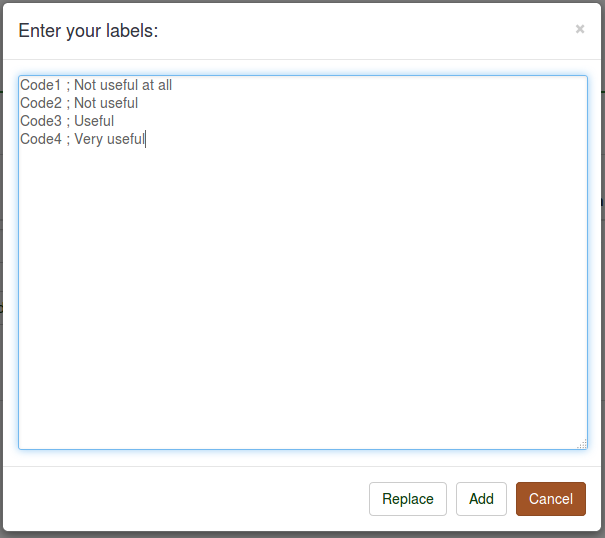
Diese so erfassten Beschriftungen können entweder den vorhandenen hinzugefügt (Schaltfläche Hinzufügen) werden oder diese ersetzen (Schaltfläche Ersetzen).
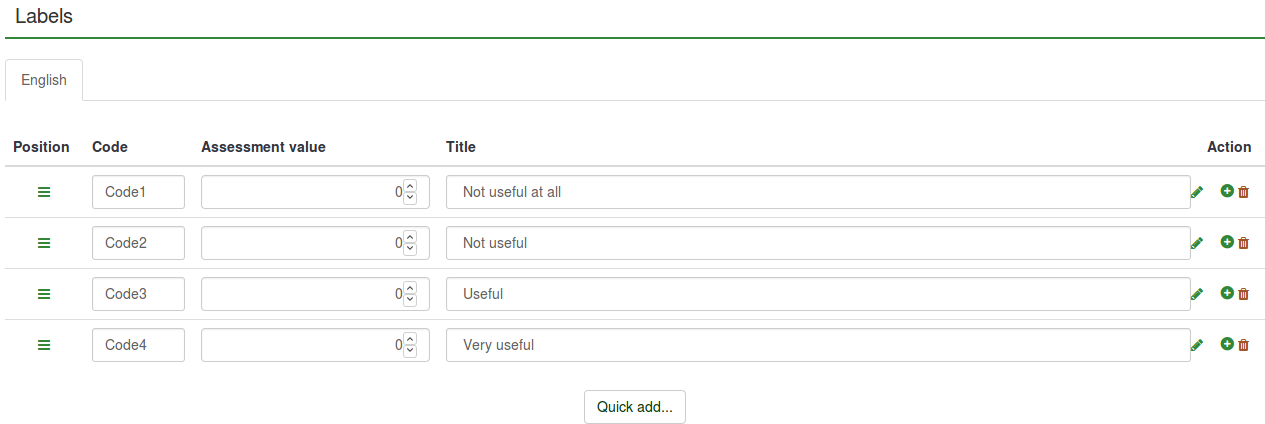
The Code is automatically added if new entrances are created. Therefore, you can type in only the title of the labels which will automatically be assigned a code:

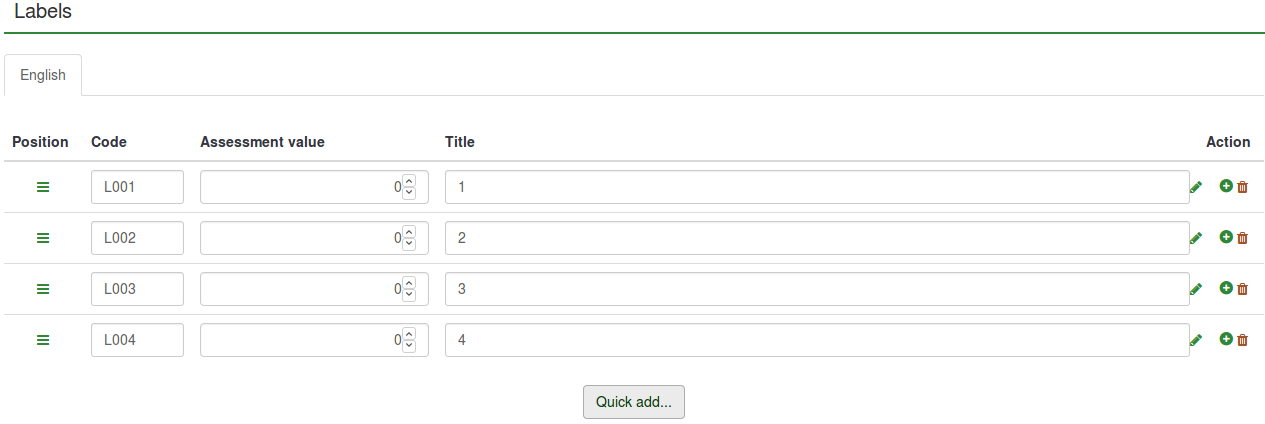
The assessment values cannot be edited/entered via this option - it has to be changed manually from the list of labels.
...delete a label
In order to delete a label, click on the red trash button (![]() ) located under the 'Action' column.
) located under the 'Action' column.
...rearrange a label
To rearrange the order of the labels, click on the green sign (![]() ) located under the column called 'Position' and re-position the label as you prefer.
) located under the column called 'Position' and re-position the label as you prefer.
...add a new language
To add a new language, Create or import new label set(s) -> Languages -> select the languages you wish to add.
To start translating the labels into another language, select the language in which you would like to translate the labels to from the upper part of the matrix.
Every label needs a code, an assessment value, and a description (as mentioned above). While the label description can be edited for all language options, label codes and assessment values can be edited only from the first language option that is located on the languages toolbar of the matrix. The order of the languages is alphabetical and it cannot be changed from LimeSurvey.
In our case, the language from where the label codes and assessment values can be changed is English. Only the label description can be edited when the Romanian tab is selected - which represents the corresponding Romanian label translation of the English label.
Once you are done with the changes, do not forget to click on the 'Save changes' button located in the upper-right part of the screen.
Examples
For a better understanding of the label sets option, let's take a look at the following examples:
- I want to use a label set as an answer list for one question;
- I want to use labels in another language as answers;
- I want to use emoticons instead of label text;
- I want to import a label set and use it as a subquestion list.
I want to use a label set as an answer list for one question
Assuming that the label set and survey are created:
- Go to the structure of the survey and create a question group - About LimeSurvey.

- Click on the Structure tab and then on the newly created question group (About LimeSurvey in our case). Look for group quick actions and choose Add new question to group:
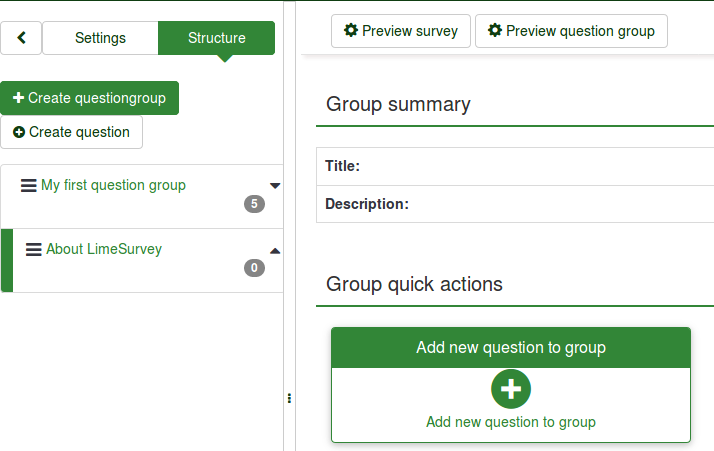
- Type in the code and text of the question.
- In order to use a label set as a set of answers, pick up the right type of question that can make use of label sets. The array question type is selected in our example:

- Save the question to add it into your question group.
- Once created, you will have to add subquestions and answers:

- Add at least one subquestion:

- Add answer options. Predefined label sets... option will be used:
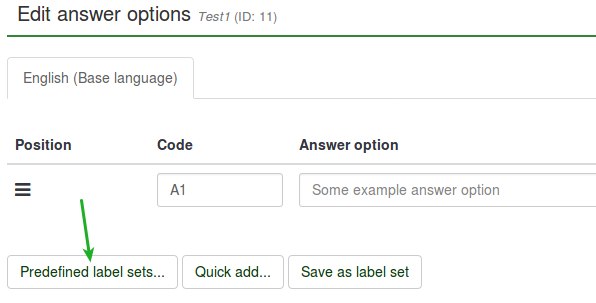
- Select the label set you want to use:
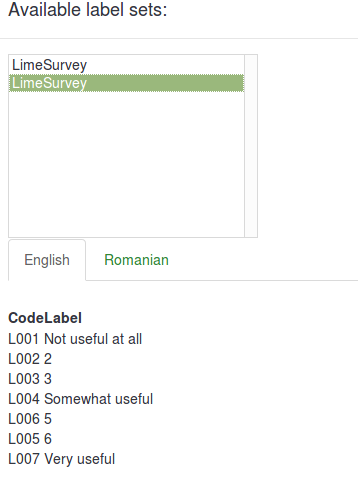
The result should look like this:
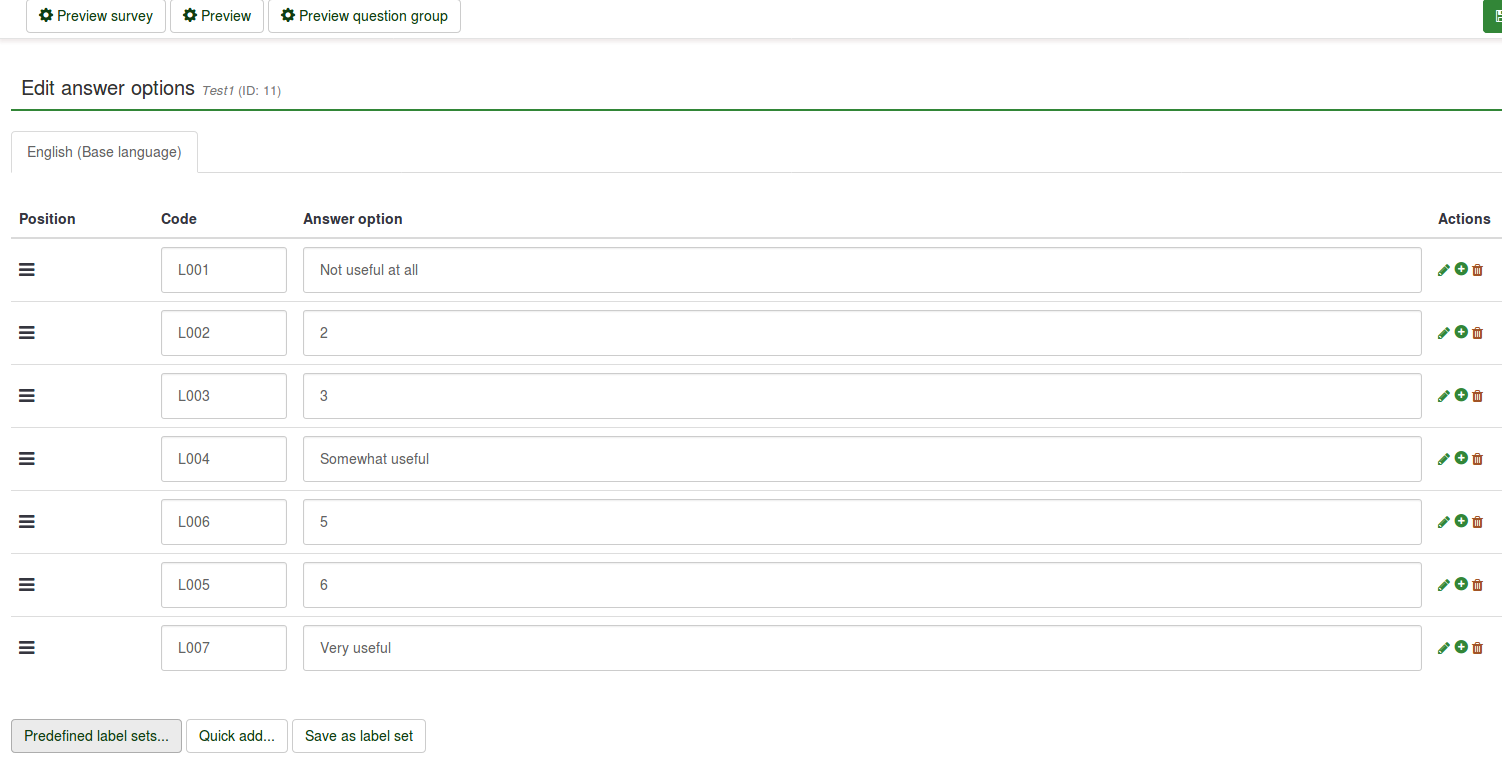
- Save & preview the question:

I want to use labels in another language as answers
- Create a label set and select the other languages you would like to use in your survey. For further details, read our wiki on how to translate a label set in other languages.
- Edit your survey (Settings -> General Settings) by adding the additional languages you want to translate to. For more details on how to create a survey, read the following wiki.
Assuming that the label set and survey are created:
- Create a question that can make use of label sets (e.g. array question type):
- Because the array question type is selected, both the subquestions and answers need to be translated.

- Translate the subquestions. Do not forget to select the right language tab for translation:

- Translate the answers. However, because we use predefined label sets, select the right language tab to add the translated label set as answer options:
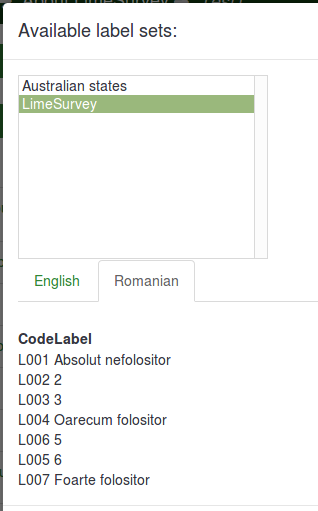

- Save & Preview the survey:

I want to use emoticons instead of label text
Assuming that the survey is created:
- Create a label set and access it. Instead of writing in the Title column, open the HTML editor by clicking on the green pen and add graphics instead of text:


The HTML editor offers you a more comprehensive view on how different options can be used to enhance your survey. It is not necessary to have HTML knowledge because the toolbar is self-explaining (for further details you can either hover the mouse over the options or click on that option for more details). By using such an editor, you can also add (for example) smileys, images and/or videos that are either hosted online or on your server.
In this example. three smileys have been added:

- Create a question that can make use of label sets as predefined answers (e.g. array question type):
- Edit the subquestions and the answer options

- Set predefined labels as answer options.

- Save and preview the question:
I want to import a label set and use it as a subquestion list
Assuming that the survey is created:
- Go to Configuration and click on Manage label sets button.
- Click on Create or import new label set(s) (in the upper-left side of the screen) -> Import label set(s). Browse your computer and select the .lsl file (the label set format).
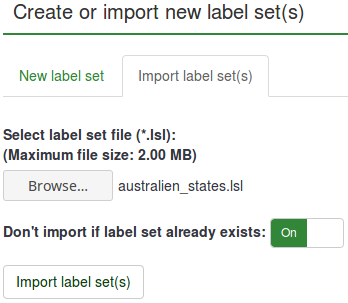
- Now that the label set was uploaded, create a question that requires the usage of subquestions (array question types).
- Edit subquestions.

- Load the imported label set:
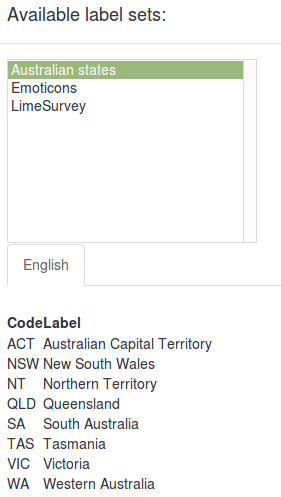
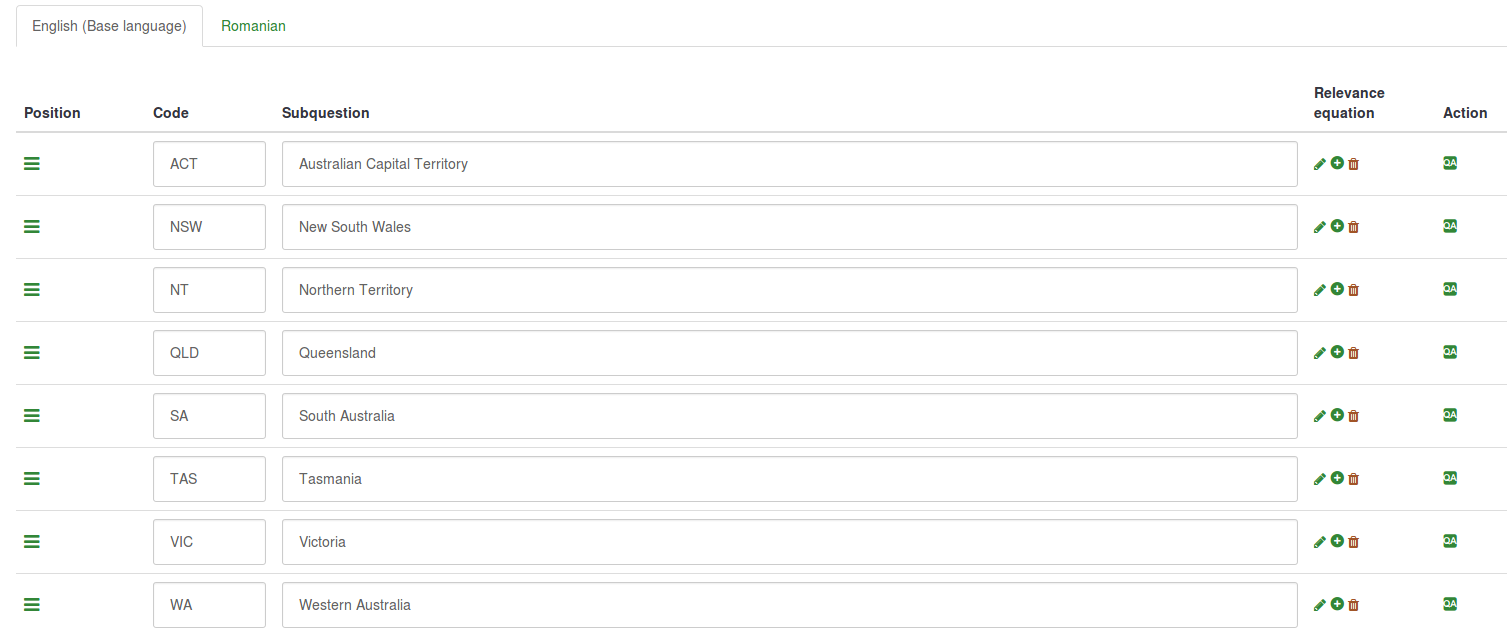
- Save and preview.
